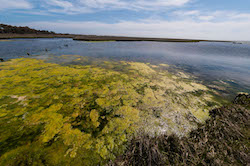SEJournal Online is the digital news magazine of the Society of Environmental Journalists. Learn more about SEJournal Online, including submission, subscription and advertising information.
TipSheet: Harmful Algal Blooms Plague Polluted Summer Waters
If “Red Tide” sounds spooky, that’s because it often is. And in most of the United States, journalists can generally bet on there being news about it in polluted summer waters.
Harmful algal blooms — the more precise scientific term for these newsmaking outbreaks — happen when algae are fertilized by excessive nutrient pollution and encouraged to grow in warmer summer waters. These so-called HABs can be dangerous to fish, animals and people. And they affect marine, estuarine or fresh waters in almost every state.
But not all HABs are red (they can be blue, green, brown, yellow, orange or red), and not all red tides are harmful. HAB actually refers to surges in the population of both microscopic algae and cyanobacteria — true bacteria that function in important ways like algae.
Most of these organisms may qualify as yucky in some way. But many cyanobacteria actually produce toxins, poisons of biological origin that harm people’s health.
Distinguishing algae and cyanobacteria
Let’s start with algae, which are primitive plant-like organisms that use chlorophyll to grow in the presence of light and nutrients.. Think pond scum. Many are single-celled, but some are multi-celled, like the giant kelp.
 |
| Algal bloom at Assateague Island National Seashore in Maryland in 2013. PHOTO: USEPA/Flickr Creative Commons |
Most algae are not directly toxic, but when large quantities grow and then (inevitably) die, their decay consumes almost all of the oxygen in a water body. This is especially true in confined freshwater bodies. When water levels of oxygen fall, you will see dead fish belly up.
Algal blooms are encouraged when large amounts of nutrients are dissolved in the water. Those nutrients include phosphorus and nitrogen, which are found in farm fertilizer, lawn fertilizer, detergent and urban runoff. So, controlling phosphorus pollution is a key to controlling algal blooms.
Farmers do not especially like government telling them what to put on their fields, so most control programs are voluntary.
On the other hand, cyanobacteria (once called “blue-green algae”) are bacteria that live through photosynthesis. Different cyanobacteria can produce a large variety of toxins that can be extremely harmful not only to fish and other marine and aquatic life, but to people.
The toxin that shut down Toledo’s water supply in 2014, known as microcystin, comes from cyanobacteria. Drinking water utilities often test for it, even though EPA rules don’t require it. While cyanobacteria deserve the bad rap, scientists remind us that they also engineered Earth’s oxygen atmosphere.
People can get sick from HABs by inhaling tiny water droplets such as sea spray, or by drinking or swimming in contaminated water, or eating contaminated seafood. The various toxins from HABs can cause eye irritation, respiratory illness, abdominal pain, vomiting and neurologic effects. Paralytic shellfish poisoning, one consequence of HAB toxins, can be fatal to humans.
Finding HAB information and forecasts
The Centers for Disease Control has a very informative web site focused on the health problems stemming from HABs.
The National Oceanic and Atmospheric Administration is a fountain of information on HABs, and recently has gotten better at forecasting blooms that are dangerous, especially in the Gulf of Mexico.
The U.S. Geological Survey is also a good source of scientific information on HABs.
The U.S. Environmental Protection Agency also provides information on HABs — particularly on ways to control the nutrients that feed them.
Another really good source of information on HABs is the Woods Hole Oceanographic Institution in Massachusetts. It has been studying HABs for a long time, and presents scientifically authoritative information in understandable ways. Among its most useful offerings are maps showing where along the U.S. coast different kinds of HABs are likely to occur.
Since HABs can render seafood toxic, your audience will want to know of any fish or shellfish advisories that apply locally. The EPA maintains a searchable online national database of fish and shellfish advisories — but a safer bet is to check in with your state and local health agencies, which are the ones usually issuing them. The same would hold true for beach closures and advisories about recreational swimming and boating.
* From the weekly news magazine SEJournal Online, Vol. 2, No. 25. Content from each new issue of SEJournal Online is available to the public via the SEJournal Online main page. Subscribe to the e-newsletter here. And see past issues of the SEJournal archived here.













 Advertisement
Advertisement 



